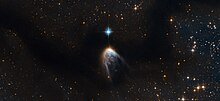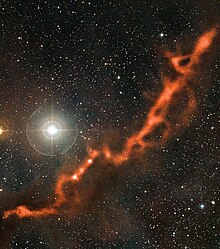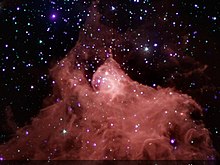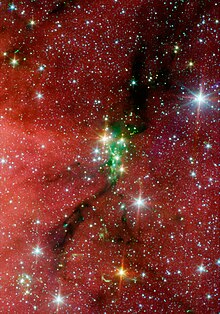Within
a few million years the light from bright stars will have boiled away
this molecular cloud of gas and dust. The cloud has broken off from the Carina Nebula.
Newly formed stars are visible nearby, their images reddened by blue
light being preferentially scattered by the pervasive dust. This image
spans about two light-years and was taken by the Hubble Space Telescope in 1999.
A molecular cloud, sometimes called a stellar nursery (if star formation is occurring within), is a type of interstellar cloud, the density and size of which permit the formation of molecules, most commonly molecular hydrogen (H2). This is in contrast to other areas of the interstellar medium that contain predominantly ionized gas.
Molecular hydrogen is difficult to detect by infrared and radio observations, so the molecule most often used to determine the presence of H2 is carbon monoxide (CO). The ratio between CO luminosity and H2 mass is thought to be constant, although there are reasons to doubt this assumption in observations of some other galaxies.
Within molecular clouds are regions with higher density, where lots of dust and gas cores reside, called clumps. These clumps are the beginning of star formation, if gravity can overcome the high density and force the dust and gas to collapse.
Occurrence
Molecular cloud Barnard 68, about 500 ly distant and 0.5 ly in diameter.
Within the Milky Way, molecular gas clouds account for less than one percent of the volume of the interstellar medium (ISM), yet it is also the densest part of the medium, comprising roughly half of the total gas mass interior to the Sun's galactic orbit. The bulk of the molecular gas is contained in a ring between 3.5 and 7.5 kiloparsecs (11,000 and 24,000 light-years) from the center of the Milky Way (the Sun is about 8.5 kiloparsecs from the center). Large scale CO maps of the galaxy show that the position of this gas correlates with the spiral arms of the galaxy. That molecular gas occurs predominantly in the spiral arms suggests that molecular clouds must form and dissociate on a timescale shorter than 10 million years—the time it takes for material to pass through the arm region.
Circinus molecular cloud has a mass around 250,000 times that of the Sun.
This distribution of molecular gas is averaged out over large distances; however, the small scale distribution of the gas is highly irregular with most of it concentrated in discrete clouds and cloud complexes.
Types of molecular cloud
Giant molecular clouds
Part of the Taurus Molecular Cloud.
The densest parts of the filaments and clumps are called "molecular cores", while the densest molecular cores are called "dense molecular cores" and have densities in excess of 104 to 106 particles per cubic centimeter. Observationally, typical molecular cores are traced with CO and dense molecular cores are traced with ammonia. The concentration of dust within molecular cores is normally sufficient to block light from background stars so that they appear in silhouette as dark nebulae.
GMCs are so large that "local" ones can cover a significant fraction of a constellation; thus they are often referred to by the name of that constellation, e.g. the Orion Molecular Cloud (OMC) or the Taurus Molecular Cloud (TMC). These local GMCs are arrayed in a ring in the neighborhood of the Sun coinciding with the Gould Belt. The most massive collection of molecular clouds in the galaxy forms an asymmetrical ring about the galactic center at a radius of 120 parsecs; the largest component of this ring is the Sagittarius B2 complex. The Sagittarius region is chemically rich and is often used as an exemplar by astronomers searching for new molecules in interstellar space.
Distribution of molecular gas in 30 merging galaxies.
Small molecular clouds
Isolated gravitationally-bound small molecular clouds with masses less than a few hundred times that of the Sun are called Bok globules. The densest parts of small molecular clouds are equivalent to the molecular cores found in GMCs and are often included in the same studies.High-latitude diffuse molecular clouds
In 1984 IRAS identified a new type of diffuse molecular cloud. These were diffuse filamentary clouds that are visible at high galactic latitudes. These clouds have a typical density of 30 particles per cubic centimeter.Processes
Young stars in and around molecular cloud Cepheus B. Radiation from one bright, massive star is destroying the cloud (from top to bottom in this image) while simultaneously triggering the formation of new stars.
Star formation
The formation of stars occurs exclusively within molecular clouds. This is a natural consequence of their low temperatures and high densities, because the gravitational force acting to collapse the cloud must exceed the internal pressures that are acting "outward" to prevent a collapse. There is observed evidence that the large, star-forming clouds are confined to a large degree by their own gravity (like stars, planets, and galaxies) rather than by external pressure. The evidence comes from the fact that the "turbulent" velocities inferred from CO linewidth scale in the same manner as the orbital velocity (a virial relation).Physics
The Serpens South
star cluster is embedded in a filamentary molecular cloud, seen as a
dark ribbon passing vertically through the cluster. This cloud has
served as a testbed for studies of molecular cloud stability.
Molecular clouds, and especially GMCs, are often the home of astronomical masers.






